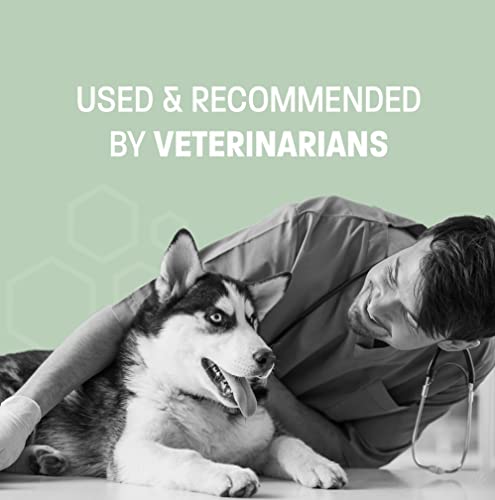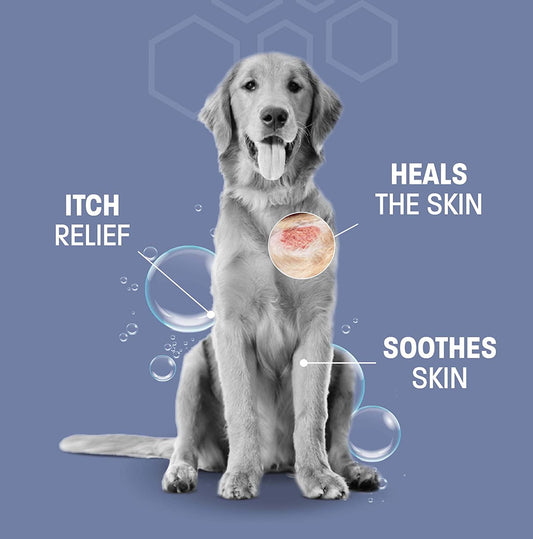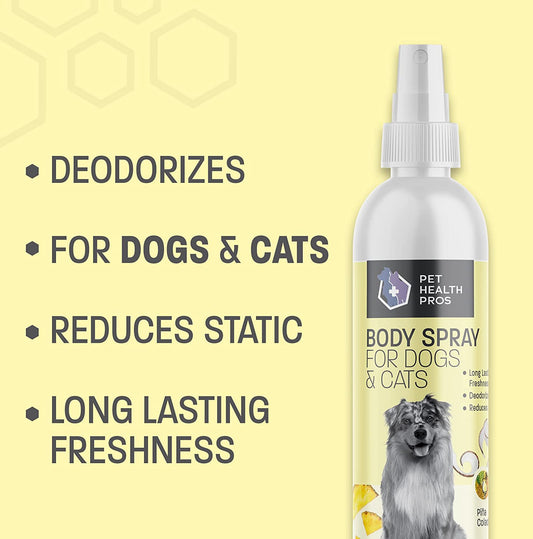Your pet looks to you for relief. Step confidently into your role as their health guardian, equipped with knowledge and support from Pet Health Pros.
To effectively navigate hot spot treatment for your beloved dogs, equip yourself with a solid understanding. Discover what hot spots are and why treating them is crucial for your furry companions. Explore the sub-sections: what hot spots are and why hot spot treatment is important for dogs.
What is a hot spot?
A hot spot is a place with Wi-Fi or internet access. You'll often find them in cafes, hotels, and public areas. They give people the freedom to connect their devices and browse the web.
Hot spots are very useful. People use them for work, leisure, or to stay in touch with loved ones. They also help people stay productive - professionals can take part in video conferences, access documents online, and do remote work.
Even rural areas have hot spots. This helps bridge the digital divide, and gives everyone access to the internet.
Why is hot spot treatment important for dogs?
Hot spot treatment is key for dogs. It helps with pain, itching, and infection. The cause is usually an allergy or insect bite. Scratching or licking can worsen it.
To treat it, you must clean the area, remove dead tissue, and apply topical medicine. Identifying the cause of the hot spot is also important to stop it from coming back.
Identifying hot spots
To effectively navigate hot spot treatment for your dog, it is crucial to first identify the signs and symptoms of these skin irritations. In this section, we will explore the common indicators of hot spots in dogs. Additionally, understanding the common causes behind these hot spots is essential in finding the appropriate remedy or cure.
Signs and symptoms of hot spots in dogs
Hot spots in dogs can be identified by certain signs and symptoms. Pet owners should look out for these indicators to know if their furry friends are suffering from this condition.
- Itching and licking: Dogs scratch and lick the affected area excessively. This can lead to redness and hair loss.
- Moist and oozing sores: Hot spots look like moist, red sores that ooze pus or clear fluid. These require quick attention.
- Foul odor: Another sign is a bad smell from the hot spot. This is due to the infection accompanying these lesions.
These skin lesions develop in areas with moisture like neck, hips, or groin. They can be triggered by allergies or fleas.
Pro Tip: Consult a vet if you spot hot spots. Early treatment can help prevent it from worsening and give relief to your dog.
Common causes of hot spots
Hotspots can be caused by a few usual factors. Such as:
- Too much device usage
- Old firmware/software
- Network clog and heavy data traffic
- Physical blockades blocking the WiFi signal
What's more, a combo of these causes can make hotspots worse. For instance, many devices using an old network with limited bandwidth and physical barriers can cause hotspots quickly.
Tip: To reduce the risk of hotspots, it is advised to keep your firmware/software up to date. Plus, adjust your network settings to avoid congestion. And make sure nothing blocks the WiFi signal.
Treating hot spots at home
To effectively treat hot spots at home in dogs, follow these simple steps. Clean the affected area thoroughly, then apply topical treatments to promote healing. For a natural approach, consider using remedies that are gentle yet effective. These sub-sections will provide you with the information you need to successfully navigate hot spot treatment for your furry companion.
Step 1: Cleaning the affected area
Cleaning hot spots must be the first step. Removing dirt, bacteria and debris helps guard against further infection and irritation.
It's also important to avoid touching or scratching the hot spot. This will worsen inflammation and delay healing. Applying an over-the-counter antibacterial ointment can help prevent bacterial growth and give relief from itching or discomfort.
By following these steps and taking the right precautions, you can clean the affected area and help it heal faster.
Step 2: Applying topical treatments
- Clean the area: Gently clean the spot with a mild antiseptic or medicated wipes. Removes dirt and bacteria.
- Trim the hair: Use pet-safe scissors or clippers to trim fur around the hot spot. Promotes better airflow.
- Apply a treatment: Apply a vet-recommended topical treatment. Could contain ingredients like hydrocortisone or aloe vera. Reduces itching and inflammation.
- Prevent licking: Use an Elizabethan collar or bitter spray. Prevents pet from undoing the progress.
Monitor behavior: Monitor your pet's behavior and keep them comfortable. Use comfortable bedding. Regularly inspect for complications.
Think of your pet's well-being and follow these steps to treat hot spots at home. Consult a vet if there's no improvement or signs of infection.
Step 3: Using natural remedies
Using natural remedies is a must to treat hot spots at home. They give relief to your pet and help heal the area. Here's a 6-step guide for effective use of natural remedies for hot spots:
- Clean the area. Start with a mild antiseptic solution or saline water. This removes dirt and bacteria.
- Apply pure aloe vera gel. It has soothing and healing properties that reduce itching and inflammation.
- Use chamomile tea compress. Brew, cool down, then soak a cloth in it. Gently apply the compress to the spot for 5-10 minutes multiple times a day. Chamomile has anti-inflammatory properties to reduce redness and swelling.
- Try coconut oil. It's a natural moisturizer and speeds healing. Apply a small amount, making sure it's fully absorbed.
- Use calendula ointment. You can find it at health stores or make it using calendula petals and olive or coconut oil. Apply the ointment to the spot, creating a barrier against infection.
- Feed good nutrition. Offer a balanced diet with high-quality proteins, omega-3 fatty acids, and fresh fruits and veggies.
Remember to consult your vet before using any natural remedies on hot spots. If they persist or worsen, seek medical help.
Pro Tip: Prevent your pet from scratching or licking the spot. Consider using an Elizabethan collar if necessary.
Seeking veterinary care
To effectively seek veterinary care for your dog's hot spot, turn to the experts for proper guidance. When to consult a veterinarian and professional treatment options are the key sub-sections to consider. These will provide you with essential solutions to navigate through hot spot treatment and ensure the well-being of your beloved canine companion.
When to consult a veterinarian
Knowing when to get vet care for your pets is crucial. Follow these 3 tips:
- Check for changes in appetite, behavior or energy.
- See a vet immediately after any accidents or injuries.
- Make sure to have regular check-ups and preventive care.
Be aware of unique details that may require you to go to the vet. Even tiny changes might suggest a health issue. As a pet owner, trust your instincts!
Pro Tip: If ever in doubt, get an expert's opinion. Your pet's health matters; professional advice is key.
Professional treatment options
When caring for your beloved pet, there are a variety of professional treatment options available. These include services from trained vets and animal healthcare professionals. Here are some key points to consider:
- Diagnostic procedures - Vets use physical exams, tests, imaging, and other diagnostic tools to identify issues.
- Medication and therapy - Depending on the diagnosis, vets may prescribe medications or recommend tailored therapy sessions.
- Surgical interventions - For injuries or medical conditions, vets may perform surgeries for your furry friend's safety.
- Dental care - Pets need dental care too - cleanings, extractions, and oral hygiene guidance.
- Specialized care - If your pet has a chronic illness, veterinary specialists in cardiology, dermatology, oncology, etc., can help.
Vets also continue learning via education programs to provide contemporary solutions.
Furthermore, the AVMA states that annual check-ups help detect potential issues early and improve your pet's quality of life.
Seeking professional treatment is a proactive way to ensure your pet's well-being and promote a happy life together.
Preventing hot spots in dogs
To prevent hot spots in dogs, tackle the issue head-on with regular grooming and hygiene practices. Addressing underlying issues is also crucial. By focusing on these two sub-sections, you can effectively minimize the occurrence of hot spots and keep your canine companion happy and healthy.
Regular grooming and hygiene practices
Brushing helps remove dead hair and avoid mats which can lead to hot spots. Give regular baths with a gentle shampoo designed for dogs. Check ears for signs of infection or wax buildup. Keep nails trimmed so as to prevent injuries leading to hot spots. Brush teeth regularly to keep gums healthy and prevent hot spots. Finally, look for signs of fleas, ticks, or parasites and treat them accordingly. Professional groomers and vets can provide essential guidance. Prevention is the key to keeping our furry friends happy and healthy!
Addressing underlying issues
It's key to groom your pup regularly. Brushing their fur helps stop hot spots.
Diet matters too. Feed your dog high-quality food for healthy skin.
Fleas and ticks can cause hot spots. Take preventive measures to stop them.
Manage stress. Create a calm environment, give mental stimulation, and use relaxation techniques like massage or aromatherapy.
Exercise your pup to prevent boredom and excessive licking or scratching.
If a hot spot develops, see a vet. They can examine your pet, identify health conditions, and prescribe treatment.
Remember, each dog is different, so observe their behavior and adjust as needed.
Conclusion
Every pet guardian needs a reliable ally. In your journey towards your dog's wellness, let Pet Health Pros be your trusted companion.
Exploring treatments for dogs' hot spots can be tricky. But, with the right care, these skin irritations can be controlled.
Prevention is key. Grooming and hygiene can help stop hot spots. Keeping the environment clean and a balanced diet will help the health, reducing the chance of hot spots.
If they do appear, quick action is needed. Find the cause and fix it. Speak to the vet if needed.
Also, cleaning the area with an antiseptic and using creams or ointments made for hot spots can help. Follow the vet's instructions on how to use them.
I had to deal with hot spots due to allergies on my dog. We had to address the allergies and treat the spot. With care and medicines, we solved the problem and stopped it from happening again.
Hot spots need patience and effort. Take precautions, act fast, and get vet help. This way, your pet will stay healthy and happy.
Frequently Asked Questions
1. What is a hot spot in dogs?
A hot spot, also known as acute moist dermatitis, is a localized area of skin inflammation and infection that is common in dogs. It typically appears as a red, oozing, and painful patch.
2. What causes hot spots in dogs?
Hot spots can be caused by various factors such as allergies, insect bites, poor grooming, underlying skin infections, or excessive moisture on the skin. Scratching, licking, or chewing at the affected area can further worsen it.
3. How can I treat a hot spot on my dog?
The first step is to gently clean the affected area with a mild antiseptic solution recommended by your veterinarian. Shaving the fur around the hot spot can help keep it clean and dry. Your vet may prescribe topical medications, oral antibiotics, or anti-inflammatory drugs to aid the healing process.
4. Can I use home remedies to treat my dog’s hot spots?
While home remedies like diluted apple cider vinegar, tea tree oil, or aloe vera gel may provide temporary relief, it's crucial to consult your vet before trying any home remedy. In some cases, applying the wrong substances can further irritate the hot spot or delay proper treatment.
5. How long does it take for a hot spot to heal?
The healing time for hot spots can vary depending on their size, severity, and the underlying cause. With appropriate treatment and prevention of further trauma to the area, smaller hot spots may heal within a week or two. Larger or more severe hot spots may take several weeks to fully heal.
6. How can I prevent hot spots in my dog?
To prevent hot spots, it's important to maintain good grooming practices, regularly inspect your dog's skin for any signs of irritation, and address any underlying health issues promptly. Avoid exposing your dog to excessive heat and moisture, and provide a balanced diet to support healthy skin and coat.








